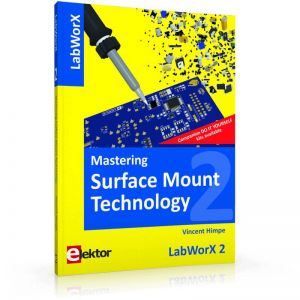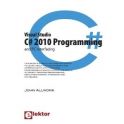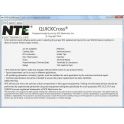No products
Publicaciones / Software
- Alarmas / Domotica
- Cables
- Cajas / Gabinetes / Organizadores
- Circuitos impresos
- Circuitos integrados / Modulos
- 4000 Series
- 7400 Series
- 74HC Series
- 74HCT Series
- 74LS Series
- ADC / DAC
- Amp. de Instrumentacion
- Amp. Operacionales
- Audio
- Comparadores
- Drivers comunicaciones
- Drivers de display y LEDs
- Drivers de potencia
- Memorias
- Microcontroladores
- Optoacopladores
- Otros c.i.
- Reguladores / Referencias / Conversores de voltaje
- Temporizadores / Relojes
- Componentes pasivos
- Conectores
- Diodos
- Displays
- Electromecanicos
- Fuentes / Adaptadores / Baterias
- Herramientas
- Instrumentos de medida
- LEDs
- Modulos RF
- Otros productos
- Proteccion de circuitos
- Publicaciones / Software
- Sensores
- Sistemas de desarrollo / SBC's
- Tiristores
- Transistores
Mastering Surface Mount Technology
15645
New product
Mastering Surface Mount Technology (SMD/SMT) is a practical book that describe tools, techniques and give advice for have success with this type of soldering
1 Item
In Stock
- Remove this product from my favorite's list.
- Add this product to my list of favorites.
More info
Dominando la tecnología de montaje en superficial lo lleva a un curso intensivo de técnicas, consejos y conocimientos para introducir con éxito la tecnología de montaje en superficie en su trabajo. Incluso si tiene un presupuesto limitado, también puede impulsar sus diseños con piezas avanzadas de separación de pines muy pequeña.
Además de explicar la metodología y el equipo, se presta atención a las tecnologías de piezas SMD/SMT y los métodos de soldadura. De una manera paso a paso, varios proyectos le presentan el manejo de piezas de montaje en superficie y las habilidades necesarias para construir con éxito ensamblajes SMD/SMT. Se revelan muchos consejos y trucos prácticos que ponen la tecnología de montaje en superficie al alcance de todos sin vaciar el banco.
Autor: Vincent Himpe
Editorial: Elektor
Páginas: 282
Año: 2012
Idioma: Inglés
Formato: Libro impreso en papel
ISBN: 978-1-907920-12-7
Descargas que acompañan al libro: Aquí
Tabla de contenido:
1. Table of contents
2. History
3. Tools
3.1. Parts manipulation
4. Soldering
4.1. Soldering iron or station
4.2. Hot-air rework stations
4.3. Hot Air handguns
4.3.1. Heat gun stand
4.3.2. Preheaters
4.4. BGA station
4.5. Reflow ovens
4.6. Temperature and power
4.7. Soldering tips
4.7.1. Anatomy of a tip
4.7.2. Prolonging tip life
4.8. Heat gun nozzles
4.9. Solder
4.10. Specialty solders
4.11. Solder paste
4.12. Paste application
4.12.1. Paste dispensers
4.12.2. Stencils
4.12.3. Stencil printers
4.12.4. Squeegees
4.12.5. Rework stencils
4.13. Solder balls
4.14. Flux
4.14.1. Rosin flux
4.14.2. No-clean flux
4.14.3. Water soluble flux
4.14.4. Flux dispensing
4.14.5. Flux for lead-free versus leaded process
4.14.6. Spattering
4.14.7. Voiding
4.14.8. Wetting problems
4.14.9. Cold solder joints
4.15. Flux remover
4.15.1. Applicators
4.16. Ultrasonic cleaner
5. Other soldering tools
5.1. Fume extractor
5.1.1. Centralized systems
5.1.2. Individual systems
5.2. Dental picks
5.3. Xacto knife
5.4. Solder wick
5.5. Applicator bottles
5.6. Soft brush
5.7. Soldering sponge
6. Magnifiers
6.1. Pocket / inspection magnifier / wearable magnifiers
6.2. Bench magnifiers with built in light
6.3. Stereo inspection microscope
6.4. Computer microscope
6.5. Vision systems
6.6. Specialized inspection systems
6.7. XRAY systems
7. Parts placement
7.1. Manual placement
7.2. Advanced manual and semi manual placement systems
7.3. Automatic placement
8. Parts storage
8.1. Factory delivered storage
8.1.1. Tape and reel
8.1.2. Stick
8.1.3. Tray
8.1.4. Bulk cassette pack
8.2. Small volume storage
8.3. Benchtop storage
8.3.1. Spring loaded boxes or mousetrap boxes
8.3.2. Sample containers
8.3.3. Photo Film containers
8.3.4. Tackle boxes
8.3.5. Jewelers and bead boxes
8.3.6. Pill boxes
8.3.7. Parts sorters
8.3.8. Labeling parts containers
9. ESD and ESD safety
9.1. What is ‘static electricity’
9.2. ESD protection
9.3. The necessity of ‘earth’
9.4. ESD safe workstation setup
9.5. ESD Safe storing of parts
9.5.1. Antistatic packaging
9.5.2. Dissipative packaging
9.5.3. Conductive material
9.6. Commercial solutions
9.6.1. Bench mat
9.6.2. ESD straps
9.6.3. ESD-safe soldering iron and tools
9.6.4. Clothing
9.6.5. Ionizers
9.6.6. Conductive flooring
9.6.7. Antistatic cleaners and surface treatment
9.6.8. Other solutions
9.6.9. Testers
9.7. Homegrown solutions
9.7.1. Bench mat
9.7.2. ESD ground plug
9.7.3. ESD safe lab jacket or lab coat
9.8. A couple of words of caution
10. Setting up an efficient workbench
10.1. The essentials
10.2. Other things to keep close at hand
10.3. Taming components
10.3.1. Dealing with tape and reel
10.3.2. Dealing with loose parts
10.3.3. Vacuum pens
10.3.4. Poster putty to the rescue
10.4. Taming the workpiece
10.4.1. Helping hands
10.4.2. The bench
11. Circuit board assemblies
11.1. Premade forms
11.2. Etched boards
11.2.1. The home route
11.2.2. The professional services
11.3. Some board terminology
11.4. Different assembly types
11.4.1. SMD Parts on one side only
11.4.2. SMD and thru-hole parts on one side only
11.4.3. SMD parts top and bottom
11.4.4. SMD parts top and bottom + through hole
12. Printed circuit boards
12.1. Some history
12.2. PCB material
12.2.1. The FR4 misnomer
12.2.2. Dielectrical constant
12.2.3. Laminate thickness
12.2.4. Copper thickness
12.3. The mechanical process
12.4. The chemical process
12.4.1. Photoplotting
12.4.2. Drill file
12.4.3. Process evolution
12.4.4. Through-hole metallization
12.4.5. Etching after metallization
12.4.6. Multilayer boards
12.4.7. Soldermask
12.4.8. Silkscreen
12.4.9. Pitfalls with soldermask and silkscreen
12.5. Surface protection
12.6. Electrical test
13. Making boards in the home or small lab
13.1. Toner transfer method
13.2. Photographic method
13.2.1. Pre-coated boards
13.2.2. Developer
13.2.3. Light source
13.3. Etching
13.3.1. Ferric chloride
13.3.2. Persulfates
13.3.3. Hydrochloric acid / Hydrogen peroxide
13.4. Post processing
14. Reflow soldering
14.1. Reflow profile
14.2. Defects
14.2.1. Mechanically induced failures
15. Sockets and package adapters
15.1. Sockets
15.2. Package adapters
16. SMD components
16.1. Resistors
16.1.1. Footprints
16.1.2. Resistor technology
16.1.3. Values
16.1.4. Value indication
16.1.5. Power rating
16.1.6. Voltage rating
16.1.7. Resistor networks
16.1.8. Practical tips for the lab resistor box
16.2. Capacitors
16.2.1. Footprints
16.2.2. Ceramic capacitors
16.3. Capacitor classification
16.3.1. Class-I
16.3.2. Class –II
16.3.3. Film capacitors
16.3.4. Tantalum capacitors
16.3.5. Technology
16.4. Electrolytic capacitors
16.4.1. Construction
16.4.2. Electrical behavior
16.5. Other capacitors
16.6. ESR: equivalent series resistance
16.7. ESL: equivalent series inductance
16.8. inductors
16.8.1. Technology
16.8.2. Derating
16.8.3. PCB inductors
17. Active components
17.1. Diodes
17.1.1. Diode packages
17.2. Transistors
17.2.1. Transistor packages
17.3. Integrated circuits
17.3.1. Small outline packages: SO
17.3.2. Power packages
17.3.3. SOJ
17.3.4. PLCC
17.3.5. TSOP / TSSOP
17.3.6. QFP / TQFP
17.3.7. QFN
17.3.8. BGA
17.3.9. Flip Chip
17.3.10. Naked Die
18. Identifying parts
19. Test tools
19.1. Test leads
19.2. Tweezer probes
19.3. Scope probes
19.3.1. Probe holders
19.4. Smart tweezers
19.5. Grabbers
19.6. Testclips
19.7. SO, PLCC and TQFP contactors
19.8. Footprint adapters
19.9. Test and ZIF sockets
20. Soldering techniques
20.1. Techniques using a standard soldering iron
20.1.1. For passive parts, 2 pin and 3 pin parts or parts with few pins
20.1.2. For coarse pitch multi-row parts
20.1.3. For TQFP or quad style packages
20.1.4. For MLF / QFN
20.2. Techniques involving a hot air sTATION
20.2.1. Passive parts
20.2.2. Multi-row parts like SO, TSSOP, QFP
20.2.3. MLF style
20.3. Solder paste and stencil techniques
20.3.1. Using a micro stencil
20.3.2. Full boards
20.4. Practice makes perfect
21. Project 1: Earth bonding plug
22. Project 2: LED Tester
22.1. Schematic
22.2. Workbench setup
22.3. Preparing the PCB
22.3.1. Preparing the component positions
22.4. Placing the first parts
22.5. Placing the passive components
22.6. Diodes and LEDs
22.7. Finishing touches
22.7.1. Applying flux
22.8. Post processing clean-up
22.8.1. Ultrasonic cleaning
23. Project 3: PWM controller for lightbulb
23.1. Schematic
23.2. Workbench setup
24. Project 4: Ring light
24.1. Assembly
24.2. Positioning the stencil
24.3. Paste application
24.4. Inspecting the solder paste deposition
24.5. Parts placement
24.6. Soldering
24.7. Thru-hole parts
25. Project 5: UV Exposure timer
25.1. The controller
25.2. Assembly
25.2.1. Workbench setup
25.2.2. Board preparation
25.3. Controller assembly
25.4. Placing parts
25.5. Installing the through-hole parts
25.6. Programming the cpu
25.7. Final assembly and wrap-up
26. Project 6: Making your own reflow oven from a pizza toaster
26.1. Schematic
26.2. Control loop
26.3. Assembly
26.4. Firmware
26.5. Operation
26.6. Downloadable Material
27. Appendix
28. Project kits
29. Index





